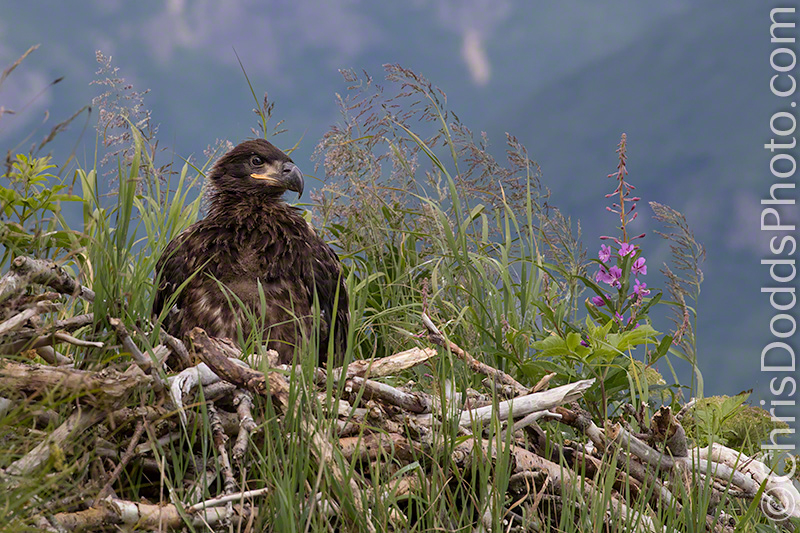 Bald Eagle Juvenile on nest with Fireweed (Hailiaeetus leucocephalus, Pygarge a tete blanche, BAEA) Aguchik Island, Kukak Bay, Katmai National Park, Alaska ©Christopher Dodds All Rights Reserved. Canon EOS 1DX Mark II, 100-400mm f/4.5-5.6 L IS II USM @400mm. ISO 800, f/18 @ 1/250s Manual. PURCHASE A PRINT or LICENSE IMAGE FOR PUBLICATION HERE.
Bald Eagle Juvenile on nest with Fireweed (Hailiaeetus leucocephalus, Pygarge a tete blanche, BAEA) Aguchik Island, Kukak Bay, Katmai National Park, Alaska ©Christopher Dodds All Rights Reserved. Canon EOS 1DX Mark II, 100-400mm f/4.5-5.6 L IS II USM @400mm. ISO 800, f/18 @ 1/250s Manual. PURCHASE A PRINT or LICENSE IMAGE FOR PUBLICATION HERE.
Here's a Juvenile Bald Eagle on it's nest on Aguchik Island in Kukak Bay, Katmai National Park from this summer. I've seen loads of Bald Eagle nests, but none were quite this beautiful.
Compared to most other raptors which mostly nest in April or May, bald eagles are early breeders: nest building or reinforcing is often by mid-February, egg laying is often late February (sometimes during deep snow in the North), and incubation is usually mid-March and early May. Eggs hatch from mid April to early May, and the young fledge late June to early July. The nest is the largest of any bird in North America; it is used repeatedly over many years and with new material added each year may eventually be as large as 4 m (13 ft) deep, 2.5 m (8.2 ft) across and weigh 1 metric ton; one nest in Florida was found to be 6.1 m (20 ft) deep, 2.9 meters (9.5 ft) across, and to weigh 2.7 metric tons). This nest is on record as the largest tree nest ever recorded for any animal. Usually nests are used for under five years or so, as they either collapse in storms or break the branches supporting them by their sheer weight. However, one nest in the Midwest was occupied continuously for at least 34 years. The nest is built out of branches, usually in large trees found near water. When breeding where there are no trees, the bald eagle will nest on the ground, as has been recorded largely in areas largely isolated from terrestrial predators, such as Amchitka Island in Alaska. - Wikipedia
Kudos
The Puffins Galore Workshop on I'ile aux Perroquets exceeded my expectations. Chris is an exceptional photographer, teacher, and all around good guy. He was quick to point out the best photographic opportunities for the group, taking into account the constantly changing weather, light and tides. He was always available to answer questions and give tips, catering to all levels of experience in the group. The accommodations were excellent and the food was first rate. Our chefs/housekeepers/hostesses, Louise and Johanne, were amazing. The photographic opportunities were endless with an unbelievable number of puffins as well as razorbills, guillemots, gulls, whales and seals. This was my first photography workshop and I am looking forward to my next adventure with Chris.
Mark Adkins Rochester| MN

